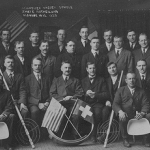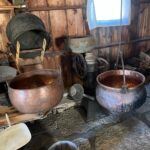The expansion of Wisconsin’s dairy industry in the 20th century not only altered the economy of the state, but it also influenced the structure of the very barns that housed the bovine champions of the industry. Barns must be adapted and altered to fit the needs of the farmer, whether that means expanding to house more livestock or utilizing newer technology. To remain useful for the farm, barn buildings needed to be adaptable. The Hefty-Blum White Barn in Green County is one example of a Wisconsin barn that underwent numerous changes to improve its use over time in relation to the changing agricultural economy. A majority of these changes occurred between 1917 and the mid-1950s as the dairy production of the farm increased to meet the ever-growing demand for dairy in Wisconsin.
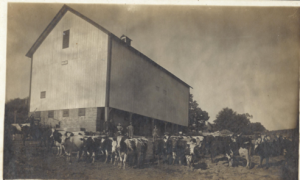
The Hefty-Blum White barn is a Swiss-style bank barn built in 1878. “Bank barns” are built into the side of a hill or embankment so that the up-hill side of the barn gives direct access to the upper portions of the barn where hay was stored, while the basement level housed milking stalls. This design allowed farmers to drive hay wagons directly into the barn. In Swiss- and German-style barns, the upper story juts out over the first level, offering shade to the area below and expanding the area for hay storage above.
The farmers on the Hefty-Blum Homestead Farm expanded their barn several times over the years in order to increase the dairy output of the farm. These expansions track with the trends in the dairy industry across the state. As herds on family farms grew larger, so did barns. The Hefty-Blum barn was originally built to house only 55 cows on its lower level, but it was expanded to house 78 by the mid-1950s.[1] To do this, the owners expanded the first story so the barn could house more cows, and they also expanded the upper stories to the barn could store more hay.
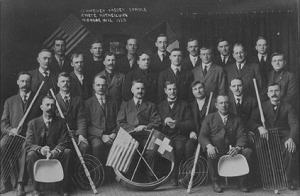
In the earlier era, milk that could not be taken quickly to market had to be transformed into more stable dairy products like butter or cheese. Swiss farmers like the ones who owned this barn introduced Swiss cheese to the Wisconsin, and by 1910 Green County was the leading producer of Swiss cheese in Wisconsin. As road conditions improved across the state and as herds expanded, farmers began to store fresh milk in their barns to be transported by dairy trucks. Reflecting this transition, Fred K. Hefty (the owner of the Hefty-Blum barn at the time) added a milk house to his barn so he could store more milk for a longer period of time. The milk was kept fresh by a cold water cooling tank.
Fred G. Blum (who owned the farm after Fred Hefty) made the final addition to the barn in 1978 when he added a lean-to on the south side. This new shed contained a mechanical feed bunk so even more cattle could be raised on the farm. The mechanical feed bunk made it possible to raise more cattle while still minimizing human labor. The feed bunk increased the number of dairy cows the barn could host to 89.[2] By that point, the Hefty-Blum barn was pushing its capacity and beginning to fall behind national trends in agriculture—as so many family farms were doing in that period. During the mid-1970s, the mantra of the US Department of Agriculture had become “get big or get out” and farmers were urged to adopt industrial agricultural practices and plough from fencerow to fencerow. But family farms like the Hefty-Blum Homestead simply could not expand to compete with industrial agriculture—and often did not want to. Five years before the Hefty-Blum barn was constructed in 1878, there were only 400 cows in all of New Glarus township. The barns of that era were designed to reflect the scale of the hard farmers could imagine surviving on each farm. Today, the average size of a herd in Wisconsin is 234 cows, and most of those cows live in pole barns constructed out of concrete, steel, and aluminum.
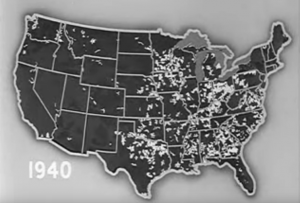
Barns in Wisconsin also changed as new technologies came to the farm. In the 1940s, for instance, rural electrification campaigns brought electricity to Wisconsin farms, and dairy farmers began to milk their cows by electric light rather than candlelight. As another example, the original Hefty-Blum barn had a single cupula on the top of the roof to help dry the hay in the upper section of the barn. This was later replaced with two metal wind vents that were able to dry the hay more effectively. This change was very important because if hay was not dried properly, it could catch fire very easily.[3]
Each of the modifications to the Hefty-Blum barn played an important role in the operation of the farm, and each modification also reflects changes in the history of agriculture in Wisconsin. From the expanded stalls for housing cows to the milk house and lean-to, the Hefty-Blum White Barn illustrates how important the adaptability of a barn was to the success of dairy farms in Wisconsin. The barn evolved with the farm, and the increasing demand for dairy products from Wisconsin farms led to an array of alterations in farm structures across the state.
Tour the Hefty-Blum White Barn today with Nancy Schumm-Burgess in this video!
FOOTNOTES
[1] Fred G. Blum, “The Known Evolving History of our White Swiss-American Barn.” Unpublished memoir, (April, 2010.) 4-5.
[2] Blum, 5.
[3] Nancy Schumm-Burgess, “Cantilevered Forebay Barns.” Video discussion of Wisconsin cantilevered forebay barns in Green County, WI. for the Wisconsin Barn Preservation Group. (Feb. 16, 2018), link.

